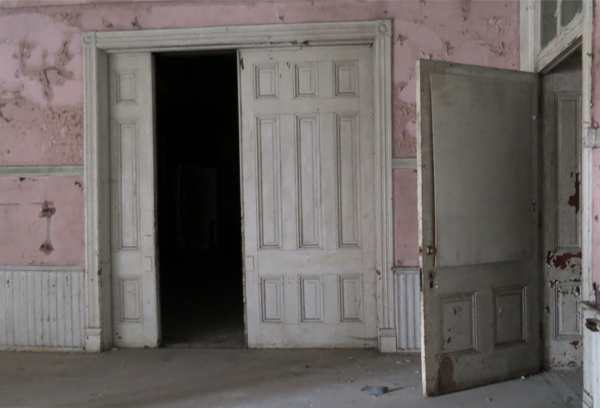
Pocket doors slide inside a wall. When closed, they can look like other doors or provide a dramatic focal point. Either way, they’re hidden when open. Which means they don’t waste space or swing into toilets, cabinets and furniture. Since they slide on tracks (instead of swinging on hinges) pocket doors can service larger openings. For these reasons architects and designers rely on the pocket door as a versatile design tool.
Sadly, pocket doors aren’t a panacea. While they look good in pictures and usually work right after installation. Designers are long gone before the pocket door’s shortcomings become painfully apparent. Builders revile these doors because they often lose adjustment and rub against the split jamb. Some regularly jump their tracks. Try working inside a finished wall and you’ll understand why builders consider the pocket door a maintenance nightmare.
More importantly, pocket doors simply aren’t secure. Yet they’re often used where privacy is important. Builders realize no amount of call backs will magically transform a pocket door into a sound proof barrier. Unlike some homeowners and designers who would rather ignore the facts.
Tips For Pocket Door Success
Avoiding pocket doors altogether is a wise design strategy. If you insist on these doors consider the following advice for maximizing success:
☑ Don’t install pocket doors for access to bedrooms, bathrooms or other areas where privacy is a concern. Especially resist these doors for powder rooms or guest suites. Unless you’re trying to get rid of unwanted squatters.
☑ By code, pocket doors can’t be installed between living space and garages. Garage access doors must be 20 minute fire rated with auto closing hinges. Pocket doors don’t qualify. Don’t use standard pocket doors on exterior walls either. The pocket can’t easily be insulated or the door sealed. However, manufacturers including Nanawall, Marvin and Sierra Pacific offer exterior “glass wall” pocket door systems, if you’re willing to thicken the wall as needed.
☑ The hidden pocket is wider than the visible opening. This area must remain clear of electrical wires and plumbing. Because the total span is at least double the visible opening, remember to size the header above accordingly.
☑ Standard interior walls are 2×4. But walls with pocket doors should be widened to 2×6 or greater. This extra width makes door installation easier and increases stiffness. Shallow electrical boxes may fit too.
☑ Pocket doors for large openings are very heavy. Use the appropriate track and roller hardware approved for the weight. Even for small openings consider heavy-duty hardware. Use box-shaped track that prevents rollers from jumping. The best hardware has 3 or 4 wheel hangers per door panel. This is one area where you shouldn’t skimp.
☑ Insist on hardware with “keyhole” shaped mounting holes so a damaged track can be replaced without removing wall finish. Also insist on a quick door disconnect system. And attach the split jamb for easy removal. Now that you have the best hardware, keep it maintained and lubricated properly, per the manufacturer’s suggestions.
☑ Make sure the door panel is properly sealed on all sides to minimize warping. Rub against the split jamb is caused by a few issues, including a warped door panel. Poorly adjusted bottom guides or a twisted pocket also cause rubbing. Guides can easily be adjusted but a warped door must be replaced. A twisted pocket requires major surgery.
Image Credits:
Dining Room Pocket Door, adapted from Paul Sableman
